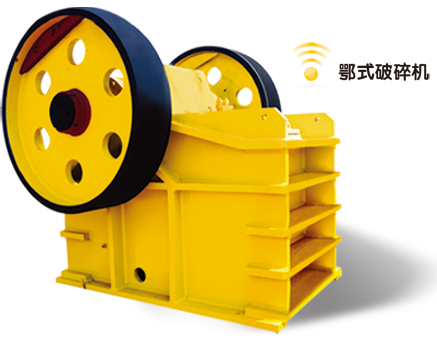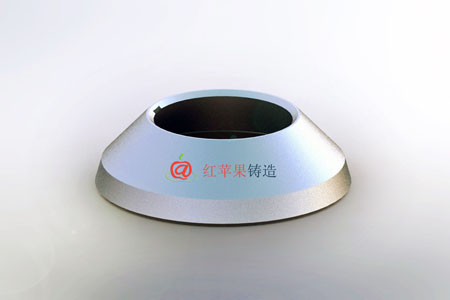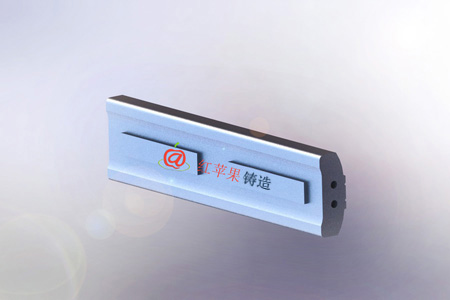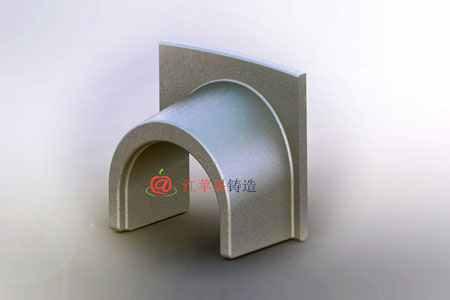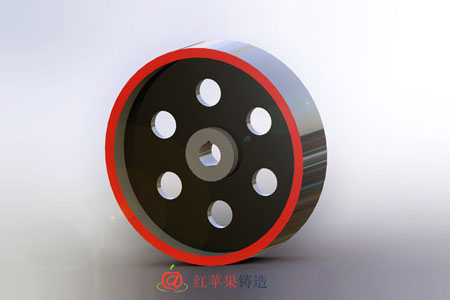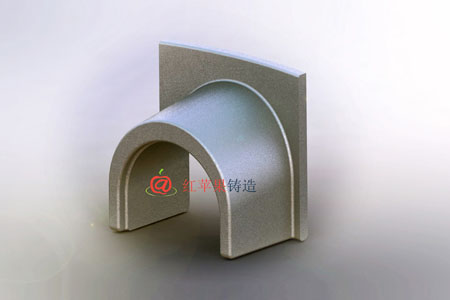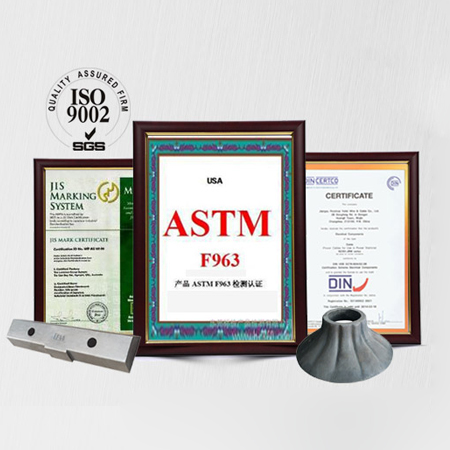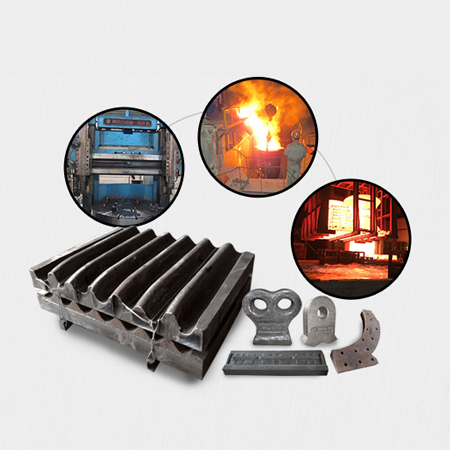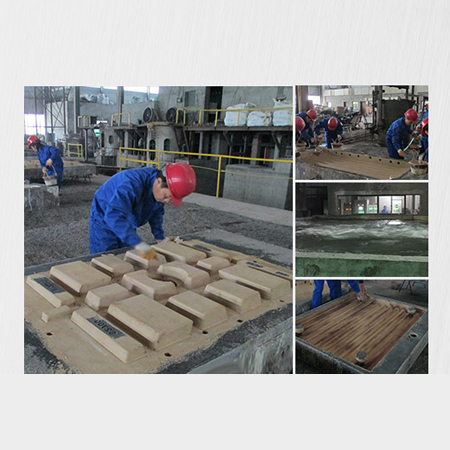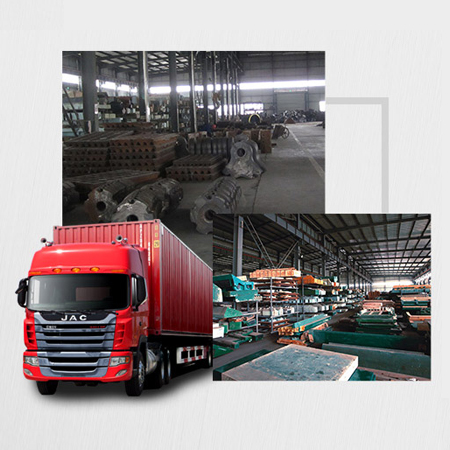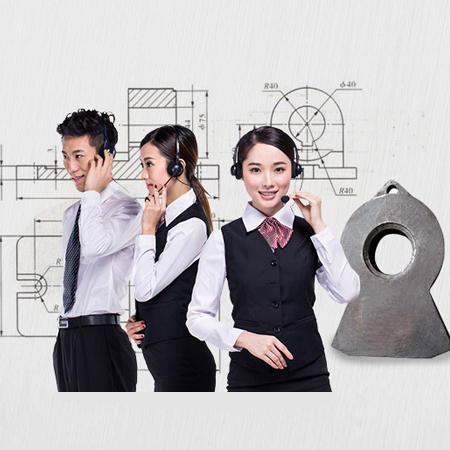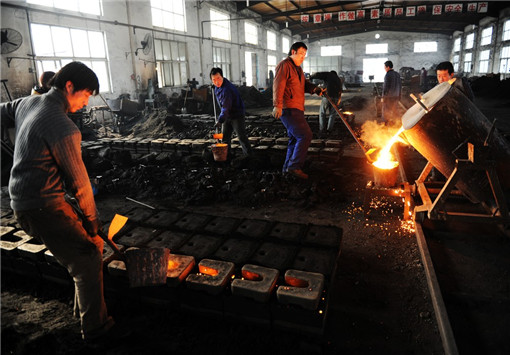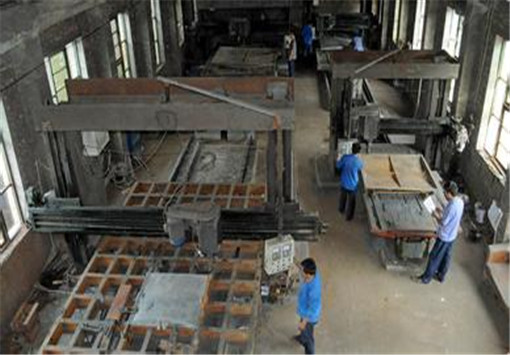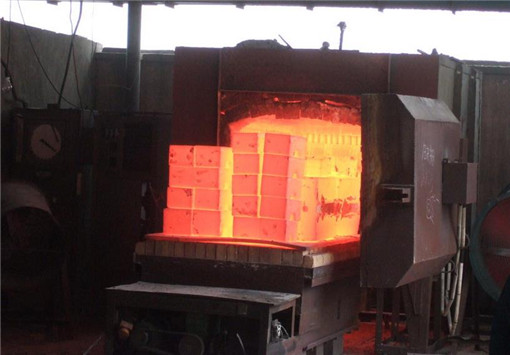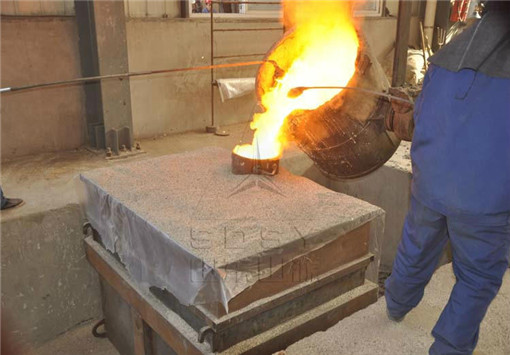Guide:The large impact crusher has the advantages of simple structure, large crushing ratio and high efficiency, and is widely used in mining, cement, metallurgy, electric power, refractory materials, glass and chemical industries. The hammer is one of the key and easy-to-wear parts of the large impact crusher. It is fixedly mounted on the rotor of the crusher by wedges. When the crusher is working, the high-speed rotating rotor drives the hammer to impact the broken ore at a line speed of 30~40 m/s. The ore block is <1500mm, the wear is very serious, and the impact force is very large. Therefore, the hammer is required to have a high Abrasion resistance and impact resistance.
Although the traditional high manganese steel has high toughness, the wear resistance is not high and the wear and tear are too large. Ordinary high-chromium cast iron has high hardness, but its toughness is not high and it is easy to break. In view of the working conditions and structural characteristics of the large impact crusher plate hammer, we have developed an ultra-high chromium cast iron plate with high comprehensive wear resistance by optimizing the composition design and heat treatment process on the existing ordinary high chromium cast iron. Hammer, the service life is more than 3 times that of ordinary high manganese steel. 2 Design of chemical composition 2.1 Determination of carbon content
Carbon is one of the key elements affecting the mechanical properties of materials, especially the impact of material hardness and impact toughness. The hardness of the material increases significantly with the increase of carbon content, and the impact toughness is greatly reduced. As the amount of carbon increases, the amount of carbides in the high-chromium cast iron increases, the hardness increases, and the wear resistance increases but the toughness decreases. In order to obtain higher hardness and ensure sufficient toughness, the carbon content is designed to be 2.6 to 3.0%. 2.2 Determination of chromium content
Chromium is the main alloying element in high-chromium cast iron. As the amount of chromium increases, the type of carbide changes, and the form of carbide transitions from MC3 to M7C3 and M23C6. M7C3 has the highest hardness in carbide and the microhardness can reach HV1300~1800. As the amount of chromium solid solution increases in the matrix, the amount of retained austenite increases and the hardness decreases. In order to ensure high wear resistance, control Cr/C=8~10, a large number of broken mesh M7C3 eutectic carbides can be obtained; at the same time, in order to obtain higher toughness, the chromium content is designed to be 25 ~27%. 2.3 Determination of molybdenum content
Molybdenum is partially dissolved in the matrix in the high chromium cast iron to improve the hardenability; a part of the MoC carbide is formed to increase the microhardness. Molybdenum is used in combination with manganese, nickel and copper, and the hardenability effect is better for thick-walled parts. Due to the thick plate hammer, considering the price of ferromolybdenum, the molybdenum content is controlled at 0.6~1.0%. 2.4 Determination of nickel and copper content
Nickel and copper are the main elements of the solid solution strengthening matrix, improving the hardenability and toughness of the chromium cast iron. Both are non-carbide forming elements, all dissolved in austenite and stabilize austenite. When the amount is increased, the amount of retained austenite increases and the hardness decreases. Considering the production cost and the limited solubility of copper in austenite, the nickel content is controlled at 0.4 to 1.0%, and the copper content is controlled at 0.6 to 1.0%. 2.5 Determination of silicon and manganese content
Silicon and manganese are conventional elements in high chromium cast iron, and their main function is deoxidation and desulfurization. Silicon reduces the hardenability but increases the Ms point. At the same time, silicon hinders the formation of carbides, which is beneficial to promote the formation of graphitization and ferrite. The content is too high and the hardness of the matrix is greatly reduced. Therefore, the silicon content is controlled to 0.4 to 1.0%. Manganese expands the austenite phase region of high chromium cast iron, solid solution in austenite, improves hardenability, and lowers martensite transformation temperature. The manganese content increases, the amount of retained austenite increases, the hardness decreases, and the wear resistance is affected. Therefore, the manganese content is controlled to be 0.5 to 1.0%. 2.6 other
S. P is a harmful element and is generally controlled to be less than 0.05% in production. RE, V, Ti, etc. are added as composite modifiers and composite inoculants to refine grains, purify grain boundaries, and improve the impact toughness of high chromium cast iron. The composition of the hammer component is shown in Table 1: Table 1 Chemical composition of the hammer (%) C Cr Mo Ni Cu Si Mn S, P 2.6~3.0 25~28 0.6~1.0 0.4~1.0 0.6~1.0 0.4~1.0 0.5~1.0 ≤0.05 3 Determination of casting process 3.1 Modeling process
The hammer weight is about 285kg, and the external dimensions are shown in Figure 1. In order to ensure the installation requirements of the hammer, the plane bending deformation of the hammer is ≤ 2mm. Due to the extremely high surface requirements of the hammer, there must be no depressions or protrusions. To ensure the compactness of the casting, we use a high-strength resin sand molding, the line shrinkage is 2.4~2.8%, and the proportion of the pouring system is ΣF: ΣF horizontal :ΣF straight = 1:0.75:1.1 for design. The horizontal casting is inclined casting, and the auxiliary heating riser and the direct external cold iron are assisted, and the process yield is controlled at 70~75%.
In the production trial production process, we have adopted three modeling processes of Figure 2, Figure 3 and Figure 4. After pouring and grinding, it was found that the plate hammers produced by the process of Fig. 2 and Fig. 3 had different degrees of surface depression and bending deformation. The method of increasing the riser could not eliminate the surface depression and bending deformation, and could not meet the installation requirements.
On the basis of summarizing the experience of the prototype production process of Figure 2 and Figure 3, we decided to adopt the horizontal molding inclined casting molding process shown in Figure 4. The surface of the hammer after casting and polishing has no depression and bending deformation, and the deformation amount is ≤ 2mm. Meet the installation requirements. The specific production process is as follows: After the sand type is made into a box, the one end of the sand type is lifted to a certain height to form a certain inclination angle (in actual production, the angle of the sand type inclination is generally determined according to the outer shape, weight and structural characteristics of the casting, The inclination angle is generally controlled at 8~20°.), the molten iron is introduced from the gate, and the molten iron entering the cavity first reaches the lowest point, and is first solidified by the chilling action of the external cold iron, and the later introduced molten iron produces the first introduced molten iron. The heavy pressure reaches the maximum value until the riser is filled with molten iron, and the riser finally solidifies to achieve sequential solidification, thereby obtaining a dense, non-shrinking casting.
3.2 smelting and deterioration gestation process
It is smelted and produced by 1000kg medium frequency electric furnace (quartz sand lining). Before smelting, limestone + broken glass composite slag agent is added. After most of the charge is melted, slag is added, then ferrosilicon and ferromanganese are added to deoxidize, and aluminum is inserted at 1kg/t. The wire is finally deoxidized and then poured out, and the melting temperature is controlled at 1500~1550 °C. In order to further improve the comprehensive wear resistance of the hammer, we improve the carbide morphology of high chromium cast iron by compound metamorphism and inoculation treatment process, reduce inclusions, purify iron liquid, refine grains, and enhance the consistency of microstructure and performance of thick castings. . The specific operation is as follows: preheat the ladle to 400~600 °C, and add a certain amount of Re-A1-Bi-Mg composite modifier and V-Ti-Zn composite inoculant [1, 2] in the ladle before pouring. After the molten iron is poured into the ladle, the poly-slag agent is thrown, so that the residual slag is rapidly aggregated, and the molten iron is further purified, and at the same time, forming a thermal insulation cover film is favorable for cast casting. The molten iron is poured after 2~3 minutes, and the pouring temperature is controlled at 1380~1420 °C. 4 Determination of heat treatment process
During the high temperature quenching process of ultra-high chromium cast iron, the solubility of alloying elements in austenite increases with increasing temperature. When the quenching temperature is low, since the solubility of carbon and chromium in austenite is low, more secondary carbides will precipitate during the heat preservation, although most of the austenite can be transformed into martensite, but because of the horse The carbon content and alloying element content of the body are low, so the hardness is not high. As the quenching temperature increases, the carbon content and the alloy content in the austenite are higher, and the martensite formed after the transformation becomes harder, so the quenching hardness is improved. When the quenching temperature is too high, the carbon content and alloy content of high-temperature austenite are too high, the stability is too high, the cooling rate is faster, the less secondary carbides are precipitated, and the more retained austenite, the quenching hardness The lower the degree [3, 4]. As the quenching holding time increases, the macro hardness of the ultra-high chromium cast iron first increases and then decreases. The effect of austenitizing holding time on the hardness of ultra-high chromium cast iron is essentially the influence of the precipitation of secondary carbides, the closeness of dissolution reaction and equilibrium state on the carbon content and alloy content of high-temperature austenite. After the as-cast super-high chromium cast iron is heated to the austenitizing temperature, the supersaturated carbon and alloying elements in the austenite are precipitated as secondary carbides, which is a diffusion process. When the holding time is too short, the precipitation of secondary carbides is too small, the austenite contains too much carbon and alloying elements, the stability is too high, the martensite transformation is incomplete during quenching, and the quenching hardness is low. As the holding time increases, the precipitation of secondary carbide increases, the stability of austenite decreases, the amount of martensite formed during quenching increases, and the quenching hardness increases. When kept for a certain period of time, the carbon content and alloy content in the austenite are balanced. If the holding time is extended, the austenite grains become coarser, resulting in an increase in the amount of retained austenite and a decrease in quenching hardness.
According to the national standard GB/T 8263-1999 "anti-wear white cast iron parts" heat treatment process specification [5], reference literature [4,6] research proposed secondary carbide precipitation and dissolution of quenching temperature, tempering temperature And the holding time, determine the best heat treatment process of the plate hammer: 1020 ° C (insulation 3 ~ 4h) high temperature fog quenching, air cooling after 3 ~ 5 minutes, 400 ° C high temperature tempering (insulation 5 ~ 6h, air cooling to room temperature). After quenching and tempering, the matrix structure is tempered martensite + eutectic carbide M7C3 + secondary carbide + retained austenite.
Since the plate hammer is thicker and heavier, in order to ensure that the casting does not crack during the heat treatment, step heating measures are adopted, and the heat treatment process is shown in Fig. 5. After hammer heat treatment, the hardness is 58~62HRC, and the impact toughness is up to 8.5J/cm2 (10×10×55mm unnotched sample).
5 Industrial application effects
The ultra-high chromium cast iron hammer we developed is applied to the Huzhou Nanfang Cement Co., Ltd. shale counter crusher. The original high-manganese steel hammer used can be used to crush 100,000 tons of shale. It can be broken after switching to ultra-high chromium cast iron. More than 300,000 tons of shale, the service life is increased by more than three times. During the operation, the hammer does not break, which greatly reduces the consumption of metal materials, and reduces the labor, materials and other expenses required to replace the hammer. It has high economic and social benefits. 6 Conclusion
(1) The horizontal casting is used to make the inclined pouring, auxiliary heating and heat-insulating riser and direct external cold iron. The surface of the hammer has no depressions and protrusions, the bending deformation is ≤ 2mm, and the structure is compact to meet the installation requirements.
(2) The best heat treatment process for the plate hammer is: 1020 ° C (insulation 3~4h) high temperature fog quenching, air cooling after 3~5 minutes, high temperature tempering at 400 °C (insulation 4~6h, air cooling to room temperature), quenching back The fire tissue is tempered martensite + eutectic carbide M7C3 + secondary carbide + retained austenite. After heat treatment, the hardness is 58~62 HRC, and the impact toughness is 8.5J/cm2. (3) The service life of ultra-high chromium cast iron plate hammer is more than three times that of ordinary high manganese steel.
Show All >


